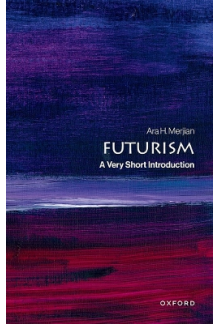- Titulinis
- Dalykinė ir mokslinė literatūra
- Futurism (A Very Short Introduction)
Ara H. Merjian
Futurism (A Very Short Introduction)
Balsavo 0
ISBN: 9780192871008
Autorius : Ara H. Merjian
Leidimo metai: 2025
Leidėjas: Oxford University Press
Puslapių skaičius: 208
Leidinio kalba: Anglų
Formatas: Minkšti viršeliai
Autorius : Ara H. Merjian
Leidimo metai: 2025
Leidėjas: Oxford University Press
Puslapių skaičius: 208
Leidinio kalba: Anglų
Formatas: Minkšti viršeliai
Pilna kaina:
13.00 €
- % perkant internetu
Kaina:
Šių parametrų produkto neturime
Likutis pakankamas
Pristatymas Lietuvoje per 3-5 savaitės. Galimas vėlavimas
Turime sandėlyje. Pristatymas Lietuvoje 1-4 d.d.
Pristatymas Lietuvoje per 3-5 savaitės. Galimas vėlavimas
Pristatymo sąlygos
Aprašymas
Very Short Introductions: Brilliant, Sharp, Inspiring
From the motorcar to the radio, modern technology radically transformed urban life by the first decade of the twentieth century. As one of Western Europe's least industrialized countries, Italy appeared impervious to such developments. It was this state of affairs at which the Futurist movement took aim. With its founding in 1909, the poet and impresario F.T. Marinetti called for a revitalization of aesthetic expression by means of "movement and aggression."
A growing cadre of Futurist painters, poets, authors, and musicians exchanged Italy's cultural patrimony for new technologies, media, and metaphors, championing machine-propelled speed and its salutary hazards. Cubist painting, collage, and sculpture lent the Futurist campaign a revolutionary style to match its rhetorical fervor. Yet whereas Cubism remained a revolution of artistic form, Futurism sought to shatter the boundaries between art and life itself.
Indeed, the movement's challenge to twentieth-century culture lay not in any specific set of images or objects, but a more comprehensive revolution of sensibility. By the mid-1910s there circulated several dozen Futurist proclamations on everything from men's clothing to set design, photography to film, dance to politics. That political impetus proved relentlessly paradoxical in origin and upshot. From its base in Milan, Futurist activity spread throughout the entire peninsula, while related movements emerged almost immediately in Moscow, Lisbon, Tiblisi, and Tokyo. Prefiguring and then propagandizing Fascist imperialism, Futurism also galvanized a range of progressive modernist phenomena. More than a century later, the “activist model” of the Futurist avant-garde remains deeply fraught in its historical implications.
ABOUT THE SERIES: The Very Short Introductions series from Oxford University Press contains hundreds of titles in almost every subject area. These pocket-sized books are the perfect way to get ahead in a new subject quickly. Our expert authors combine facts, analysis, perspective, new ideas, and enthusiasm to make interesting and challenging topics highly readable.
From the motorcar to the radio, modern technology radically transformed urban life by the first decade of the twentieth century. This Very Short Introduction explores the ideas, works, key figures, and development of the Futurist movement in Italy and beyond, in the context of the turmoil and rapid change of the early 20th Century.
From the motorcar to the radio, modern technology radically transformed urban life by the first decade of the twentieth century. As one of Western Europe's least industrialized countries, Italy appeared impervious to such developments. It was this state of affairs at which the Futurist movement took aim. With its founding in 1909, the poet and impresario F.T. Marinetti called for a revitalization of aesthetic expression by means of "movement and aggression."
A growing cadre of Futurist painters, poets, authors, and musicians exchanged Italy's cultural patrimony for new technologies, media, and metaphors, championing machine-propelled speed and its salutary hazards. Cubist painting, collage, and sculpture lent the Futurist campaign a revolutionary style to match its rhetorical fervor. Yet whereas Cubism remained a revolution of artistic form, Futurism sought to shatter the boundaries between art and life itself.
Indeed, the movement's challenge to twentieth-century culture lay not in any specific set of images or objects, but a more comprehensive revolution of sensibility. By the mid-1910s there circulated several dozen Futurist proclamations on everything from men's clothing to set design, photography to film, dance to politics. That political impetus proved relentlessly paradoxical in origin and upshot. From its base in Milan, Futurist activity spread throughout the entire peninsula, while related movements emerged almost immediately in Moscow, Lisbon, Tiblisi, and Tokyo. Prefiguring and then propagandizing Fascist imperialism, Futurism also galvanized a range of progressive modernist phenomena. More than a century later, the “activist model” of the Futurist avant-garde remains deeply fraught in its historical implications.
ABOUT THE SERIES: The Very Short Introductions series from Oxford University Press contains hundreds of titles in almost every subject area. These pocket-sized books are the perfect way to get ahead in a new subject quickly. Our expert authors combine facts, analysis, perspective, new ideas, and enthusiasm to make interesting and challenging topics highly readable.
From the motorcar to the radio, modern technology radically transformed urban life by the first decade of the twentieth century. This Very Short Introduction explores the ideas, works, key figures, and development of the Futurist movement in Italy and beyond, in the context of the turmoil and rapid change of the early 20th Century.
Atsiliepimai (0)
Palikite atsiliepimą

